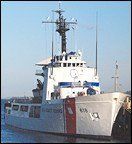Recent laws in New Jersey and California represent a disturbing trend that will negatively impact a practice’s ability to collect monies from patients, as well as expose them to significant penalties if the practice does not follow the mandatory guidelines to a T. Please be aware that a similar law may be coming to your state. The time to act is before the law is passed.
Chiropractic and the U.S. Coast Guard - A Call to Arms
In a previous article, I discussed the chiropractor's role in performing medical qualification examinations of commercial motor vehicle (CMV) operators, and the importance in maintaining the role of chiropractic in this program.1 In that article, I maintained that chiropractors are fully qualified to perform the required physical exa-minations. The core curriculum of every chiropractic college provides the necessary training and the National Board of Chiropractic Examiners (NBCE) assures clinical competency in all the required areas of examination.2 Every chiropractor who has successfully completed the national boards and who maintains a license has already demonstrated competency in the examination process. In fact, the NBCE had a clinical competency examination, Part IV, for over eight years before the medical profession developed one.

Chiropractors should be participating in every examination program from which we are not legislatively barred. Furthermore, we should actively pursue that participation if our access is being blocked by policy or ignorance. And when we are excluded or otherwise prohibited from participation by policy or law, we need to work actively to change that situation, either through public comment or legislative action.
One such opportunity is on the near horizon. The United States Coast Guard (USCG) requires medical qualification examinations of all merchant mariners. The medical qualifications are defined in what is called a Navigation and Vessel Inspection Circular (NVIC). The current NVIC regarding Physical Evaluation Guidelines for Merchant Mariner's Documents and Licenses3 defines the physical and medical requirements for a merchant mariner's license and who may perform those examinations. The NVIC states that it "contains standards to guide physicians, physician assistants, and licensed nurse practitioners, in examining merchant seamen." As it does not specifically include chiropractors in that list, merchant mariners may not receive their physical evaluations from chiropractors. Anyone wishing to review the current NVIC can find it by reviewing the index page and clicking on the link for the February 1998 circular.
This is not dissimilar to the rule that existed for CMV operators prior to 1992. Until the Federal Motor Carrier Safety Regulations were amended that year, CMV operators were not allowed to use chiropractors to perform their medical qualification examinations. Today, many employers and their drivers choose chiropractors to perform these examinations.
The U.S. Department of Transportation clearly sees the value of including chiropractors as examiners for their CMV operators. They have approached the profession through the Federation of Chiropractic Licensing Boards to solicit our participation in the development of new provider guidelines. The Federal Motor Carrier Safety Administration wants 10,000 chiropractors to participate as examiners. Chiropractic is included at various levels in most other federal programs as well, including Medicare, the military hospital system, and the Veterans' Administration. It is now time for us to demand inclusion as examiners of Merchant Marines.
Through conversations I have had wih senior medical personnel in the USCG, I have learned that the USCG cannot use chiropractors as examiners, because their enabling legislation states in 46CFR10.209 that a "license shall submit a certification by a licensed physician or physician assistant that he or she is in good health and has no physical impairment or medical condition which would render him or her incompetent to perform the ordinary duties."4 It does not specifically refer to chiropractors and apparently chiropractors are not considered "physicians" under federal law. Additionally, the senior medical personnel at the USCG do not feel that chiropractors are qualified to perform these examinations.
The new medical NVIC regarding physical examination guidelines, which will replace NVIC-98 (Physical Evaluation Guidelines for Merchant Mariner's Licenses and Documents), is due to be published in the Federal Register for public comment in late April or May of this year.
Therefore, our task is threefold. First, during this upcoming public comment period, which will be 30-60 days in length, our profession needs to let the USCG know that we are interested in being examiners and that we will demand parity and an even playing field with other health care providers. Second, we need to demand legislative change of 46CFR10.209 and other sections of 46CFR to enable us to fully participate in these programs. And third, through our good work, we need to demonstrate to the USCG that chiropractic is a mature profession with the requisite training and competency to participate in these programs as an equal player with our medical peers.
Whether you as an individual want to perform these exams or not, it is important that as many chiropractors as possible write during the public comment period and express their views on why chiropractors should be allowed to perform these examinations. With the constant outside pressures trying to cause contraction of our profession and practice rights, we not only need to remain vigilant in the maintenance of our current practice rights and privileges, but we also should take advantage of every opportunity that avails itself to broaden our participation in programs from which we are currently excluded. There is an old business adage, "Growth or death." To assure the continued stability of the chiropractic profession, it is our responsibility to assure our growth at every opportunity.
As soon as the new NVIC is posted and the public comment period is opened, I will post another article in this periodical. At that time, I will provide the specifics on how to enter public comment regarding this important matter. Alternately, you can keep a "weather eye" on the Federal Register for the upcoming USCG posting.
References
- Kenney LM. DOT physical examinations: defending what we have . Dynamic Chiropractic, March 26, 2006.
- Job Analysis of Chiropractic 2005. National Board of Chiropractic Examiners, Greeley CO, 2005.
- Physical Evaluation Guidelines for Merchant Mariner's Licenses and Documents. U.S. Coast Guard NVIC, February 1998. Online reference.
- Online reference.



